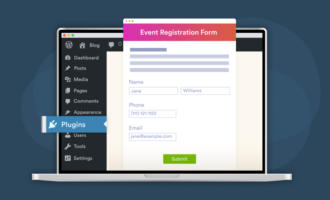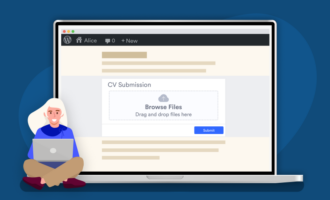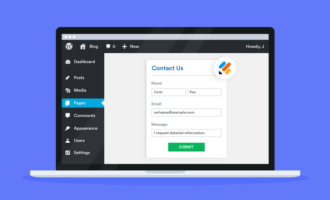6 tips on making money with a WordPress blog
- Create an affiliate partnership
- Sell related products and services
- Place display ads
- Write sponsored content
- Create different tiers of content
- Ask for donations
Blogging on WordPress is incredibly popular. There are more than 409 million people who read over 20 billion pages of blog content every month on WordPress alone.
But blogging isn’t just a way to share ideas, build credibility, and start conversations; it’s also a great way to make money.
Whether your WordPress blog is a personal project or part of your business strategy, there are multiple tactics you can use to monetize your content and turn it into a revenue stream.
In this article, you’ll find six different strategies on how to make money with a WordPress blog. All you need is a bit of business savvy, and your blogging skills can take you as far as you’d like to go!
1. Create an affiliate partnership
One of the best low-effort and low-cost ways to make money with your WordPress blog is through affiliate partnerships.
When you engage in affiliate marketing, you intentionally promote third-party products through your blog content (such as through a product review) and provide links to those brands’ websites. When someone purchases an item using your affiliate link, you earn a commission.
You may choose to work with affiliate partners, such as Amazon Associates or other affiliate networks, or even work directly with a third-party brand. The key is to properly create and use your affiliate links to the products, as that’s the only way to track your affiliate sales. If your audience doesn’t use your affiliate link, the brand won’t know that you contributed to that specific sale.
It’s also vital to disclose to your blog readers that you’re using affiliate links.
Pro Tip
When you’re choosing which affiliate brands to work with, go with ones that carry products you and your audience members are passionate about. For example, if you have a blog on parenting, then promoting parenting-related products with your audience is a natural fit.
2. Sell related products and services
You can also make money with your WordPress blog by selling related products and services.
For example, you can sell merchandise, such as T-shirts or mugs, that include your blog’s brand. You can also sell products and services related to your niche; if your blog is on all things automotive, you may want to sell certain types of car parts, for example. If your blog provides expert tips for running a small business, you can sell consultancy packages.
With this strategy, it’s important to keep your sales items highly relevant to your blog content. Otherwise, you’ll start to look like a department store rather than a place where people can go to get expert content on a particular topic. Be strategic and choosy when deciding what to sell, so you have the best chance of engaging your audience.
Keep in mind that this strategy does include a certain amount of overhead costs, as you’ll need to deal with manufacturing, inventory, shipping, and other logistics.
Pro Tip
Online selling requires the use of order forms. You can find custom forms for WordPress through Jotform’s easy-to-use WordPress plug-in, which has templates for product orders, work orders, and much more.
3. Place display ads
Many bloggers place display ads on their blog posts as a way to earn revenue from their content. Display ads can take the form of static ads, popups, or native ads; those ads may be pay-per-click (PPC) or pay-per-impression (PPI), depending on the ad network you choose to go with.
In order for this strategy to be successful, you need to have a large blog readership, as you only make money if someone clicks on an ad (in the pay-per-click model) or views an ad (in the pay-per-impression model). If your audience is small, however, it’s unlikely this will be a profitable revenue-generating tactic for you.
Pro Tip
Be very careful with the number and type of ads you place on your blog, as most readers find them unsightly and frustrating. Too many flashing or popup ads alongside your content could turn readers off. This tactic can also cause you to lose credibility with your audience, which could further hurt your popularity or readership.
4. Write sponsored content
If you have a large blog following, another strategy for monetizing your content is sponsorships. You can partner with brands that are related to your niche and write blog posts about their products and solutions in exchange for a one-time payment.
For some bloggers, sponsored posts not only provide a revenue boost, but also a treasure trove of new content ideas.
For example, if you have a blog on hair care, you could partner with a hair care or hair color company and write sponsored posts that include their products, different ways to use them, and all the benefits they provide. Keep in mind that you’re legally required to disclose to your audience that you’re writing a sponsored post.
Pro Tip
If brands aren’t approaching you to write sponsored content, you can go to them. Put together a media kit that includes information about your blog, your reach, social media following, audience demographic, and other relevant information. Strategically determine which brands may be the best sponsors for you and reach out to their marketing departments.
5. Create different tiers of content
While most blogs offer content to their readers for free, some blogs offer paid tiers of content alongside their free content as a way to create a revenue stream. You can create memberships for your content and encourage readers to subscribe for access to exclusive information.
Videos, webinars, e-books, and audio content are some options you can include in your membership tiers. Keep in mind that this paid content must be exclusive in some way or have high value. For example, if your blog is on fashion, you could sell a content subscription that provides members with 30 days of style suggestions for each month to make dressing fashionably a cinch.
Pro Tip
Make it easy to sign up for a membership or for additional content with Jotform’s easy-to-use membership and subscription forms. You can easily embed them into your WordPress website, creating a seamless experience for your audience.
6. Ask for donations
Depending on your niche and your audience, another way to make money with your WordPress blog could be to ask for donations. In some niches, this tactic won’t work as well, but in others, you could find a lot of success. For example, if your blog regularly offers helpful information that others use frequently (think Wikipedia, for example), some readers may be inclined to give you a couple of dollars every now and then.
Keep in mind that donations won’t provide a predictable income, and you can also lose some credibility by asking for them.
For example, if your blog is all about making money from side hustles, the donation strategy may not be right for you. However, if your blog is about raising awareness for humanitarian crises around the world, the donation tactic may fit in well. Use this strategy wisely if it works within your industry.
Pro Tip
Use Jotform to create donation forms for your website and collect payments. Jotform integrates with dozens of different payment processors so you can accept online donations. Track your incoming donations so you can personally thank your donors. Jotform Tables is a great way to see, manage, and track everyone who donates to your blog.
While blogs are a great way to share your expertise, opinions, and thoughts, they can also be a great way to make money. No matter what you write about, Jotform can support you as you turn your blog into a revenue-generating machine.
Photo by Andrea Piacquadio







































































Send Comment: